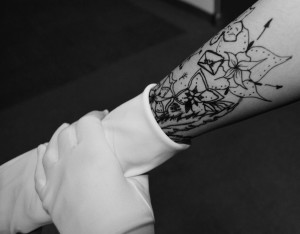Double Standards, Double the Controversy
Breaking down respectability politics in dresscode
Photo: Elle Vaughn
Many people believe that there is a sense of inequality in school dress codes, and ours here at St. George’s is no different. Our ideas of professionalism and appropriateness are not only affected by what our parents tell us is right, but also by cultural and social norms.
But what are our community values exactly, and how do they affect our dress code here at school? The St. George’s dress code can be seen as lenient compared to others, but it still reflects the double standards present in our culture at large.
For example, even in athletic practices, boys are allowed to remove their entire shirts, but girls cannot train in their sports bras.
As a Varsity cheerleader, I am repeatedly reminded that it would be a social faux pas for me to allow the casual slip of a bra strap during games, and even practice.
I can already see the comments now, most of which I’ve heard in the hallways. “It’s different for girls!” “That would be a distraction!”
Let’s all just admit it: There is nothing inherently sexual about girls working out in workout wear.
I mean, I know it’s called Victoria’s Secret, but truthfully, everyone knows it’s there. And is it really so bad if people see it?
I understand that most of us feel that modesty is important, and that’s fine, but to ingratiate in the minds of young girls that they are undeserving of respect unless they conform to traditional rules of respectability? That’s another story altogether.
In a culture that teaches women to cover up their bodies and be ashamed of them, it is not surprising that our dress code would reflect such ideas. A study conducted by Washington Education states that by age 13, 53% of American girls are dissatisfied with their bodies, and by the time they reach age 17, this number spikes to 78%.
These numbers are undoubtedly affected by what girls are shown in the media. From a very young age, girls are taught to aspire to a very specific standard of attractiveness, and that if they do not fit this standard that they should be ashamed of themselves and hide their bodies, which have been deemed as unacceptable.
They are also taught to place their physical attractiveness very high on their list of priorities. They are conditioned to believe that their bodies are their most valuable assets.
When girls begin to take interest in “perfecting” themselves, however, they are labeled vapid and unintelligent. Furthermore, their sexuality is stolen from them and exploited. They are shamed for not being sexy enough, and then shamed for being too “sexy” or revealing, and are told to cover their bodies if they want to be respected.
We have to admit that these contradictory expectations are not only confusing, but terribly tiring.
However, this double standard is not just for women, and the gender-based hypocrisy in the dress code applies to boys, too, primarily about the shaving requirement and the fact that boys are not allowed to wear earrings.
A clean-shaven face, one that is framed with trimmed hair and piercing-free ears, is viewed as the pinnacle of professionalism. However, no one ever asks why this is. Not to make a stretch here, but not only does this policy ignore multiculturalism, the coexistence and representation of diverse cultures, but it also subscribes to respectability politics and Eurocentric standards of decency.
Some American black boys, for example, see ear piercings as a part of their culture, as do many other cultures across the globe. Male earrings are, however, closely associated to American hip-hop culture, which often carries connotations of “thug” culture and the stereotypical aesthetic of black people who commit crimes. It is important to remember that all of the men who enjoy this style and fit this aesthetic do not fit the negative connotations associated with it.
Earrings are beautiful on women, so why are we hesitant to believe that they are also beautiful on men? Not only are they beautiful, but in some cases may be ceremonial. For example, boys in Nepal, Sri Lanka, and other Asian countries pierce their ears as a sign of their newfound adulthood.
Not to mention the fact that many successful men have or have had earrings at some point. There is nothing fundamentally unprofessional about them. Will Smith, for example, is one of the most successful men in Hollywood, and he attends even his business meetings donning his diamond studs! Of course, this might have something to do with the fact that his industry is more forgiving when it comes to such things, but who is to say that other industries should not follow suit?
This is a harmful idea to reinforce, and it is more detrimental than people think.
The problem here isn’t the dress code itself. In theory, the dress code is in place for the good of the student body. It is a mechanism that strives toward the goal of a school environment that is as distraction-free as possible.
But why do we consider these things distracting? What about our culture is so pervasive that it sexualizes the nonsexual body parts of women and holds men to a standard of professionalism that is not reflective of multiple cultures and beliefs?
Culture does shape people, but it does not make them. People make culture. Therefore, if our culture is one that enforces and perpetuates hypersexualization and respectability politics, we have the power to change it.
Because, honestly…how stimulating can my shoulders really be?















